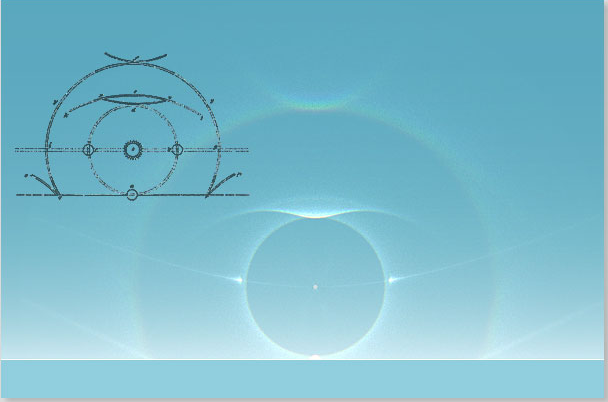Parry Halo Display 1820
Parry Halo Display 1820: A Fascinating Atmospheric Phenomenon
In the harsh conditions of the Canadian Arctic on April 8, 1820, while icebound off Melville Island, William Edward Parry made a remarkable observation. Parry was leading a British expedition in search of the North West Passage and had been trapped in the ice since the previous September. Despite the challenging circumstances, Parry's fortitude and skills allowed him to accurately document a mesmerizing atmospheric display known as the Parry Halo Display 1820.
The Parry Halo Display 1820 consisted of several distinct optical phenomena that adorned the sky. Parry drew a 22° halo touching the horizon, accompanied by an outer 46° halo. These halos were caused by the refraction and reflection of sunlight by ice crystals suspended in the atmosphere. Additionally, a parhelic circle, passing through the sun and extending around the sky, was clearly visible. An upper tangent arc, parallel to the horizon, and a bright area on the horizon below the sun, representing the tip of the lower tangent arc, were also part of the spectacle. The 46° halo was further adorned with a circumzenithal arc.
One particularly fascinating aspect of Parry's observations was the identification of a previously unrecorded arc directly above the upper tangent arc, now known as the Parry Arc. This unique arc, along with other rare arcs, is produced by a specific crystal orientation referred to as the "Parry orientation." The Parry Arc has since become an important feature in atmospheric optics studies.
Initially, two other arcs extending from the 46° halo towards the horizon were incorrectly attributed to infralateral arcs drawn by Parry. However, Michael Schroeder's analysis using HaloSim simulation revealed that these arcs were actually subhelic arcs. Subhelic arcs are formed when rays enter the end faces of singly oriented column crystals, undergo internal reflection twice, and exit through the opposite end face. Parry's accurate depiction of these arcs provides valuable insight into the complex interplay of light and ice crystals in the atmosphere.
It is worth noting that while Parry drew the parhelic circle as parallel to the horizon, the simulation renders it as curved due to the "camera" projection used. This difference in perspective does not diminish the significance of Parry's observations but rather highlights the need for careful interpretation when comparing hand-drawn diagrams to simulated representations.
The Parry Halo Display 1820 serves as a reminder of the incredible beauty and complexity of atmospheric optics. It demonstrates the intricate dance between sunlight and ice crystals, resulting in a mesmerizing array of halos, arcs, and circles. Parry's meticulous observations in extreme conditions provide a valuable contribution to our understanding of these phenomena.
In conclusion, the Parry Halo Display 1820 showcases the remarkable ability of William Edward Parry to observe and document atmospheric optics in challenging circumstances. His accurate depictions of halos, arcs, and circles have contributed significantly to our knowledge of these fascinating phenomena. The identification of the Parry Arc and the exploration of crystal orientations add depth to our understanding of the interplay between light and ice crystals in the atmosphere. The Parry Halo Display 1820 stands as a testament to the beauty and complexity of our natural world.

A display observed by William Edward Parry on April 8, 1820 while icebound off Melville Island in the Canadian Arctic.
Parry's two small wooden ships comprising a British expedition to find the North West Passage had been trapped in the ice since the previous September. They had endured a harsh winter and April continued frigid. They were not to escape for a further three months, narrowly avoiding being frozen in for a second winter.
It says much for Parry's fortitude and skills that he was able in these conditions to observe very accurately the halo display.
He drew a 22° halo touching the horizon and an outer 46° halo. A parhelic circle passed through the sun and extended around the sky. An upper tangent arc was clearly marked. The tip of the lower tangent arc was the bright area on the horizon directly below the sun. The 46° halo was topped by a circumzenithal arc.
The previously unrecorded arc directly above the upper tangent arc is now called a Parry Arc and the crystal orientation producing it and other rare arcs is the "Parry orientation".
Parry drew two other arcs extending outwards at the horizon from the 46° halo and these were earlier attributed to infralateral arcs incorrectly drawn by Parry. However, Michael Schroeder points out that the HaloSim simulation shows strong arcs extending from the horizon just as Parry drew them. These are subhelic arcs produced by rays entering the end faces of singly oriented column crystals, being internally reflected twice and then leaving through the opposite end face.
Parry drew the parhelic circle parallel to the horizon as indeed it is, the 'camera' projection of the simulation renders it curved. The display was simulated by poorly (randomly) oriented, plate and singly oriented column crystals. Only a few percent of Parry oriented crystals were necessary to produce the arc that bears his name.
Note: this article has been automatically converted from the old site and may not appear as intended. You can find the original article here.
Reference Atmospheric Optics
If you use any of the definitions, information, or data presented on Atmospheric Optics, please copy the link or reference below to properly credit us as the reference source. Thank you!
-
<a href="https://atoptics.co.uk/blog/parry-halo-display-1820/">Parry Halo Display 1820</a>
-
"Parry Halo Display 1820". Atmospheric Optics. Accessed on April 30, 2024. https://atoptics.co.uk/blog/parry-halo-display-1820/.
-
"Parry Halo Display 1820". Atmospheric Optics, https://atoptics.co.uk/blog/parry-halo-display-1820/. Accessed 30 April, 2024
-
Parry Halo Display 1820. Atmospheric Optics. Retrieved from https://atoptics.co.uk/blog/parry-halo-display-1820/.